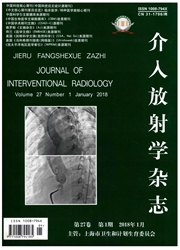

 中文摘要:
中文摘要:
目的 评价CT引导下经皮穿刺同轴活检术对肺部空洞性病变的诊断价值。方法 回顾性分析因肺部空洞性病变而于本院行CT引导下经皮穿刺同轴活检术患者的相关临床资料(n=48)。根据病变大小(A1<20 mm,n=12;B1≥20 mm,n=36),针道距离(A2<5 cm,n=33;B2≥5 cm,n=15),空洞壁厚度(A3<5 mm,n=18;B3≥5 mm,n=30)将其分为A、B 2组。分别计算A、B 2组的敏感性、特异性及准确性,并采用Fisher’s确切概率法比较其差异是否有统计学意义。结果 病理诊断恶性病变38例,良性病变7例。CT引导下经皮穿刺同轴活检术对肺部空洞性病变的敏感性、特异性及准确性分别为95%、87.5%、93.8%。对于不同大小、不同针道距离以及空洞壁厚度不同的病变,其诊断准确性差异均无统计学意义(P>0.05)。结论 对于肺部空洞性病变的诊断,CT引导下经皮穿刺同轴活检术具有较高的灵敏度、特异度和准确率,其准确性与病变大小、针道的距离以及空洞壁厚度无关。
 英文摘要:
英文摘要:
Objective To evaluate the diagnostic accuracy of CT guided percutaneous coaxial biopsy in pulmonary cavitary lesions. Methods 48 patients with pulmonary cavitary lesions who underwent CT guided percutaneous coaxial biopsy were enrolled in this study. Cavitary lesions were divided into two groups according to their size(A,1〈20 mm, n= 12;B1≥20 mm, n= 36), length of needle path (A2〈5 cm, n=33; B2≥5 cm, n=15), and thickness of cavity wall (A3〈5 mm, n=18; B3≥5 mm, n=30). Sensitivity, specificity, and diagnostic accuracy were calculated and compared between the two groups with the Fisher's exact test. Results There were 38 malignant and 7 benign lesions. The sensitivity, specificity, and accuracy were 95%, 87.5%, and 93.8% for all lesions. The diagnostic accuracy was not significantly different according to their size, length of the needle path, and thickness of the cavity wall l all P〉0.05 ). Conclusion CT guided percutaneous coaxial biopsy is a useful diagnostic procedure for pulmonary cavitary lesions with a moderate sensitivity, specificity and accuracy. The diagnostic accuracy is not influenced by their size, length of the needle path, and thickness of the cavity wall.
 同期刊论文项目
同期刊论文项目
 同项目期刊论文
同项目期刊论文
 期刊信息
期刊信息
